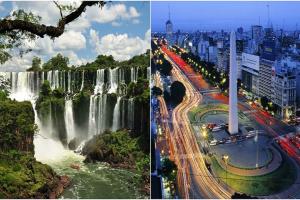Litoral
Included provinces | Formosa, Chaco, Misiones, Corrientes, Santa Fe, Entre Ríos.
Geography | Mostly flat terrain. Region bathed by major rivers, mainly the Paraná and Uruguay, which flow into the River Plate. Jungle in the far northeast, and forests and marshlands to the south. Sub-tropical wet climate to the north and mild wet climate to the south.
Economy | Fishing. Cattle raising. Dairy industry. Forestry and related industries (wood, paper). Export-oriented crops (soybean, wheat, citrus, yerba mate). Biofuels. Hydroelectric power. Tourism.
Main urban center | Rosario [city located in Santa Fe province], Argentina’s third most populous city.


1. Geographical location of Litoral. 2. Iguazu Falls, in Misiones province, named one of the world’s “seven wonders”. 3. Esteros del Iberá (Iberá marshlands), in Corrientes province. 4. Palmar (Palm tree forest), in Colón, Entre Ríos province. 5. Flag Memoria, in Rosario, Santa Fe province. 6. Gualeguaychú carnival, in Entre Ríos province.
Northwest
Included provinces | Jujuy, Salta, Catamarca, La Rioja, Tucumán, Santiago del Estero.
Geography | Mostly mountainous terrain, with heights increasing from east to west, to the peaks of 6,000 meters in the far west. Broad valleys between the mountain formations. Sub-tropical climate, mainly dry, with temperatures falling in areas of high altitude.
Economy | Subsistence farming, with herds of llamas and alpacas in the far north. Industrial exploitation of minerals such as lead, copper, lithium and salt. Cultivation of sugar cane, lemons and tobacco. Wine industry: Torrontés strand. Tourism.
Main urban center | Tucumán [capital city of Tucumán province], Argentina’s fifth most populous city.


7. Geographical location of Northwest. 8. Seven Colours Hill, in Purmamarca, Jujuy province. 9. Salinas Grandes (Great Saltworks), in Jujuy province. 10. Train to the Clouds, tourist hotspot in Salta province. 11. Talampaya National Park, in La Rioja province. 12. Skydiving over Tucumán city.
Cuyo
Included provinces | San Juan, Mendoza, San Luis.
Geography | Mountainous terrain, with heights increasing from east to west. At the far west, in Mendoza province, stands Aconcagua mountain, America’s highest mountain, with 6,960 meters high. Sparse vegetation. Mild climate, predominantly dry, desert-like.
Economy | Wine industry: Malbec wine. Cultivation of apples and olives. Tourism.
Main urban center | Mendoza [capital city of Mendoza province] , Argentina’s fourth most populous city.


13. Geographical location of Cuyo. 14. Atuel River, in Mendoza province. 15. Vineyards at the foot of the Andes mountain range, in Mendoza province. 16. Mendoza city, in Mendoza province. 17. Las Leñas, ski resort in Mendoza province. 18. Moon Valley, in San Juan province.
Sierras | Highlands
Included province | Córdoba.
Geography | Mostly mountainous terrain, with lakes and scattered valleys, along which streams can be found. Arid vegetation. Mild climate.
Economy | Argentina’s main industrial hub, where a wide range of goods are manufactured, from foodstuff –dairy products, treats– to aircrafts, including also cars, car parts, agricultural machinery and locomotives. Tourism.
Main urban center | Córdoba [capital city of Córdoba province ], Argentina’s second most populous city.


19. Geographical location of the Sierras | Highlands. 20. Stream in Mina Clavero. 21. Traslasierra Valley landscape. 22. Corner of Córdoba city. 23. Highlands stream. 24. Carmaker, in Córdoba city.
Pampas | Grasslands
Included provinces | La Pampa, Buenos Aires.
Geography | Mostly flat terrain, which translates into large tracts of fertile land. Mild, humid climate. Buenos Aires is densely populated, concentrating 40 % of the country’s population.
Economy | Major export-oriented crops: soybeans, wheat, corn, sunflower. Livestock specializing in cattle. Strong industrial base, including steel and petrochemical industry.
Main urban center | La Plata [capital city of Buenos Aires province], Argentina’s sixth most populous city.


25. Geographical location of the Pampas | Grasslands. 26. Tigre, in Buenos Aires province. 27. Pampas plains. 28. Train in Buenos Aires province. 29. Castle near Miramar, in Buenos Aires province. 30. Beach in Mar del Plata, in Buenos Aires province.
Buenos Aires
This is Buenos Aires city, which is an autonomous district, separated from Buenos Aires province.
Geography | Argentina’s capital city and its main entry point. It is located on the west bank of the Río de la Plata | River Plate. Flat terrain. Mild, humid climate.
Characteristics | Main education hub in the country. Eclectic architecture due to immigration. Major hub for artistic and cultural activity, with a predominance of theaters, museums and libraries.
Economy | Tourism. Services. Software and pharmaceutical industry.


31. Geographical location of Buenos Aires city, marked with black rectangle. 32. Puerto Madero district. 33. Caminito in La Boca neighborhood. 34. The iconic Obelisk on 9 de Julio Avenue. 35. Buenos Aires city underground. 36. Planetarium, in Palermo neighbourhood.
Patagonia
Included provinces | Neuquén, Río Negro, Chubut, Santa Cruz.
Geography | West: mountainous terrain, cold and wet climate. East: plateau (high and arid plains), dry climate, with strong winds.
Economy | Exploitation of hydrocarbons: significant reserves of oil and shale gas. Wind and hydroelectric power. Livestock specializing in sheep. Tourism: glaciers, ski resorts.
Main urban center | Neuquén [capital city of Neuquén province].


37. Geographical location of Patagonia. 38. Perito Moreno Glacier, in Santa Cruz province. 39. El Chaltén, in Santa Cruz province. 40. Whale watching in Península de Valdez, Chubut province. 41. Nahuel Huapi lake, near Bariloche, in Río Negro province. 42. Catedral mountain, in Bariloche, in Río Negro province.
Far south
Included province | Tierra del Fuego, Antarctica and South Atlantic Islands.
+ This province comprises Tierra del Fuego island, located south of the Argentine mainland territory (blue circle), the Malvinas Islands (green circle) and South Georgia and South Sandwich Islands, and a portion of the Antarctic continent (right panel). Argentina exercises effective sovereignty over Tierra del Fuego island while Malvinas Islands, South Georgia and South Sandwich Islands and the Argentine Antarctic territory are claimed territories.
+ The Malvinas Islands, located 600 km east of the coast of the Argentine mainland, were inherited by Argentina after their emancipation from Spain in 1810, but have remained occupied by the United Kingdom since 1833, when London invaded the archipelago. Argentina continues to claim effective sovereignty over this territory.
+ As for Antarctica, Argentina has maintained uninterrupted presence in Antarctic territory since 1904, when it became the first country to settle on the continent. Currently, Argentina has 6 permanent bases and 7 summer bases. This territory is also claimed –no effective sovereignty is exercised– since under 1959 Antarctic Treaty all sovereignty claims over the Antarctic continent were frozen.
Geography | Tierra del Fuego: mountainous terrain, permanent snow, glacial valleys and lakes, sub-arctic climate. Malvinas Islands: archipelago of over 200 islands, the largest of which are Gran Malvina (west) and Soledad (east), rocky terrain, sub-polar oceanic climate. Antarctica: predominantly mountainous terrain, climate ranging from sub-polar to polar from north to south.
Economy | Tierra del Fuego: Tourism. Fishing. Livestock specializing in sheep. Electrical appliances industry.
Main urban center | Ushuaia [capital city of Tierra del Fuego, Antarctica and South Atlantic Islands province], which is known as "the end of the world", as it is considered the world’s southernmost city.


43. Geographical location of the Far South. 44. Southern Fuegian Railway, on the island of Tierra del Fuego. 45. Ushuaia, on the island of Tierra del Fuego. 46. Les Ecleraires lighthouse, in the Beagle Channel, Tierra del Fuego Island . 47. Penguins. 48. Esperanza Base, in Antarctica.


